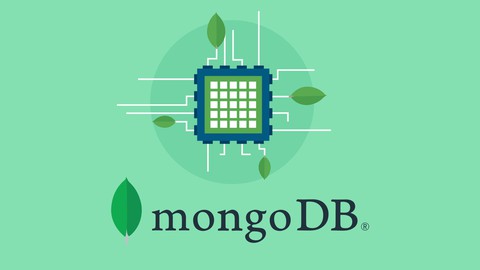
MongoDB – The Complete Developer's Guide 2024
MongoDB – The Complete Developer's Guide 2024, available at $94.99, has an average rating of 4.6, with 278 lectures, based on 25219 reviews, and has 178679 subscribers.
You will learn about Learn what document databases are and how data is organized with MongoDB Learn how to perform CRUD operations with MongoDB Don't stop at the basics – learn all about writing complex MongoDB queries, in-depth and with practical examples! Write efficient and well-performing queries to fetch data in the format you need it Use all features MongoDB offers you to work with data efficiently This course is ideal for individuals who are Developers or data scientists who plan on (or are already) working with MongoDB or Everyone who's interested in NoSQL databases or Both beginner and advanced MongoDB users who want to explore all the core features It is particularly useful for Developers or data scientists who plan on (or are already) working with MongoDB or Everyone who's interested in NoSQL databases or Both beginner and advanced MongoDB users who want to explore all the core features.
Enroll now: MongoDB – The Complete Developer's Guide 2024
Summary
Title: MongoDB – The Complete Developer's Guide 2024
Price: $94.99
Average Rating: 4.6
Number of Lectures: 278
Number of Published Lectures: 266
Number of Curriculum Items: 286
Number of Published Curriculum Objects: 274
Original Price: $139.99
Quality Status: approved
Status: Live
What You Will Learn
- Learn what document databases are and how data is organized with MongoDB
- Learn how to perform CRUD operations with MongoDB
- Don't stop at the basics – learn all about writing complex MongoDB queries, in-depth and with practical examples!
- Write efficient and well-performing queries to fetch data in the format you need it
- Use all features MongoDB offers you to work with data efficiently
Who Should Attend
- Developers or data scientists who plan on (or are already) working with MongoDB
- Everyone who's interested in NoSQL databases
- Both beginner and advanced MongoDB users who want to explore all the core features
Target Audiences
- Developers or data scientists who plan on (or are already) working with MongoDB
- Everyone who's interested in NoSQL databases
- Both beginner and advanced MongoDB users who want to explore all the core features
Join this bestselling MongoDB course to learn all about this extremely popular database and query language from the ground up, in great detail and with many practical examples!
–
MongoDB is one of the most important NoSQL databases you can work with. It’s extremely popular and MongoDB developers are in high demand!
No matter if you’re building web applications, mobile applications or any other kind of application or if you’re a data scientist – you’ll need to work with data. Storing data, querying it efficiently and minimizing complexities whilst optimizing performance are crucial tasks.
MongoDB makes working with data simple – it’s built on a philosophy that prioritizes performance and efficiency.
In this course, you learn all about MongoDB from scratch. No prior MongoDB or database experience is required!
In detail, you’ll learn:
-
How to install and use MongoDB locally and in the cloud (MongoDB Atlas)
-
How to perform CRUD (Create, Read, Update, Delete) operations on MongoDB databases
-
How to filter for data efficiently
-
How to work with both the Mongo Shell and drivers (e.g. Node.js driver)
-
How to increase performance by using indexes (and how to use the right indexes!)
-
How to use the amazing “Aggregation Framework” that’s built into MongoDB
-
What replica sets and sharding are
-
How to use MongoDB Atlas – the cloud solution offered by MongoDB
-
How to use the serverless platform (Stitch) offered by MongoDB
-
And much more!
This course is a hands-on course – you’ll learn by writing code/ commands. We’ll work on a wide variety of example data and use-cases and by the end of the course, you’ll have all the knowledge you need to work with MongoDB in your next project!
This course is for you, no matter which programming language you plan on using, you’ll learn a uniform way of interacting with MongoDB that can be easily applied to any language.
This course is for you:
-
if you’re brand-new to MongoDB and databases in general
-
if you got some basic database or even MongoDB experience – in this course, there are different entry points you can choose from!
-
if you are a web or mobile app (or desktop app) developer who considers using MongoDB
-
if you’re working in a team that considers using MongoDB (or already does use it)
-
if you are primarily using SQL-based databases so far and you want to explore the most popular NoSQL alternative
This course is NOT for you:
-
if you’re looking for a guide on administrating MongoDB servers => This course focuses on the commands/ queries you write, it’s NOT an administration course. I will show (in detail) how to deploy a ready-to-use cloud MongoDB solution that follows best practices though.
Course Curriculum
Chapter 1: Introduction
Lecture 1: Introduction
Lecture 2: What is MongoDB?
Lecture 3: Join our Online Learning Community
Lecture 4: The Key MongoDB Characteristics (and how they differ from SQL Databases)
Lecture 5: Understanding the MongoDB Ecosystem
Lecture 6: General Setup Instructions & Installing MongoDB on macOS
Lecture 7: Installing MongoDB on Windows
Lecture 8: Installing the MongoDB Shell
Lecture 9: Installing mongoimport
Lecture 10: Time To Get Started!
Lecture 11: Shell vs Drivers
Lecture 12: MongoDB + Clients: The Big Picture
Lecture 13: Course Outline
Lecture 14: How To Get The Most Out Of The Course
Chapter 2: Understanding the Basics & CRUD Operations
Lecture 1: Module Introduction
Lecture 2: Understanding Databases, Collections & Documents
Lecture 3: The Shell & MongoDB Drivers for Different Languages
Lecture 4: Creating Databases & Collections
Lecture 5: Understanding JSON Data
Lecture 6: Comparing JSON & BSON
Lecture 7: Create, Read, Update, Delete (CRUD) & MongoDB
Lecture 8: Finding, Inserting, Deleting & Updating Elements
Lecture 9: Understanding "insertMany()"
Lecture 10: Diving Deeper Into Finding Data
Lecture 11: "update" vs "updateMany()"
Lecture 12: Understanding "find()" & the Cursor Object
Lecture 13: Understanding Projection
Lecture 14: Embedded Documents & Arrays – The Theory
Lecture 15: Working with Embedded Documents
Lecture 16: Working with Arrays
Lecture 17: Accessing Structured Data
Lecture 18: Wrap Up
Lecture 19: Useful Resources & Links
Chapter 3: Schemas & Relations: How to Structure Documents
Lecture 1: Resetting Your Database
Lecture 2: Module Introduction
Lecture 3: Why Do We Use Schemas?
Lecture 4: Structuring Documents
Lecture 5: Data Types – An Overview
Lecture 6: Data Types in Action
Lecture 7: Data Types & Limits
Lecture 8: How to Derive your Data Structure – Requirements
Lecture 9: Understanding Relations
Lecture 10: One To One Relations – Embedded
Lecture 11: One To One – Using References
Lecture 12: One To Many – Embedded
Lecture 13: One To Many – Using References
Lecture 14: Many To Many – Embedded
Lecture 15: Many To Many – Using References
Lecture 16: Summarizing Relations
Lecture 17: Using "lookUp()" for Merging Reference Relations
Lecture 18: Planning the Example Exercise
Lecture 19: Implementing the Example Exercise
Lecture 20: Understanding Schema Validation
Lecture 21: Adding Collection Document Validation
Lecture 22: Changing the Validation Action
Lecture 23: Wrap Up
Lecture 24: Useful Resources & Links
Chapter 4: Exploring The Shell & The Server
Lecture 1: Module Introduction
Lecture 2: Finding Available Options
Lecture 3: Setting "dbpath" & "logpath"
Lecture 4: Exploring the MongoDB Options
Lecture 5: MongoDB as a Background Service
Lecture 6: Using a Config File
Lecture 7: Shell Options & Help
Lecture 8: Useful Resources & Links
Chapter 5: Using the MongoDB Compass to Explore Data Visually
Lecture 1: Module Introduction
Lecture 2: Exploring the MongoDB Compass
Lecture 3: Useful Resources & Links
Chapter 6: Diving Into Create Operations
Lecture 1: Module Introduction
Lecture 2: Creating Documents – An Overview
Lecture 3: Understanding "insert()" Methods
Lecture 4: Working with Ordered Inserts
Lecture 5: Understanding the "writeConcern"
Lecture 6: The "writeConcern" in Practice
Lecture 7: What is Atomicity?
Lecture 8: Importing Data
Lecture 9: Wrap Up
Lecture 10: Useful Resources & Links
Chapter 7: Read Operations – A Closer Look
Lecture 1: Module Introduction
Lecture 2: Methods, Filters & Operators
Lecture 3: Operators – An Overview
Lecture 4: Query Selectors & Projection Operators
Lecture 5: Understanding "findOne()" & "find()"
Lecture 6: Working with Comparison Operators
Lecture 7: Querying Embedded Fields & Arrays
Lecture 8: Understanding "$in" and "$nin"
Lecture 9: "$or" and "$nor"
Lecture 10: Understanding the "$and" Operator
Lecture 11: Using "$not"
Lecture 12: Diving Into Element Operators
Lecture 13: Working with "$type"
Instructors
-
Academind by Maximilian Schwarzmüller
Online Education -
Maximilian Schwarzmüller
AWS certified, Professional Web Developer and Instructor
Rating Distribution
- 1 stars: 124 votes
- 2 stars: 177 votes
- 3 stars: 1442 votes
- 4 stars: 7544 votes
- 5 stars: 15930 votes
Frequently Asked Questions
How long do I have access to the course materials?
You can view and review the lecture materials indefinitely, like an on-demand channel.
Can I take my courses with me wherever I go?
Definitely! If you have an internet connection, courses on Udemy are available on any device at any time. If you don’t have an internet connection, some instructors also let their students download course lectures. That’s up to the instructor though, so make sure you get on their good side!
You may also like
- Top 10 Financial Technology Courses to Learn in December 2024
- Top 10 Agile Methodologies Courses to Learn in December 2024
- Top 10 Project Management Courses to Learn in December 2024
- Top 10 Leadership Skills Courses to Learn in December 2024
- Top 10 Public Speaking Courses to Learn in December 2024
- Top 10 Affiliate Marketing Courses to Learn in December 2024
- Top 10 Email Marketing Courses to Learn in December 2024
- Top 10 Social Media Management Courses to Learn in December 2024
- Top 10 SEO Optimization Courses to Learn in December 2024
- Top 10 Content Creation Courses to Learn in December 2024
- Top 10 Game Development Courses to Learn in December 2024
- Top 10 Software Testing Courses to Learn in December 2024
- Top 10 Big Data Courses to Learn in December 2024
- Top 10 Internet Of Things Courses to Learn in December 2024
- Top 10 Quantum Computing Courses to Learn in December 2024
- Top 10 Cloud Computing Courses to Learn in December 2024
- Top 10 3d Modeling Courses to Learn in December 2024
- Top 10 Mobile App Development Courses to Learn in December 2024
- Top 10 Graphic Design Courses to Learn in December 2024
- Top 10 Videography Courses to Learn in December 2024























